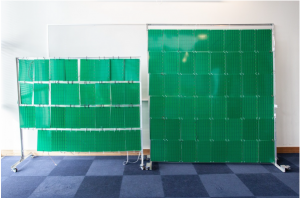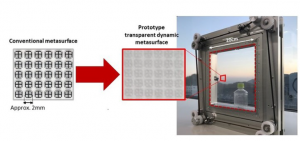Published on: March 29, 2021
The purpose of the MINTS project is to work on perfecting existing mmWave technologies and go beyond that to look towards the future, exploring new research areas that could be the basis for the next-generation wireless communications.
Various groundbreaking technologies have been proposed for 6G, such as the use of Terahertz band, Visible Light Communications (VLC), air-to-ground (A2G) communications aided by drones (UAVs), and Reconfigurable Intelligent Surfaces (RIS) [1]. Today, we will talk about RIS, a topic that is being researched by two of our MINTS ESRs, Marco Rossanese (ESR9) and Amir Ashtari Gargari (ESR10).
A Reconfigurable Intelligent Surface is a quasi-passive thin structure that manipulates the electromagnetic waves impinging upon itself, to fulfill the user’s desired goals. This is a novel concept because so far, the environment has been considered an enemy in communication theory; engineers could simply accept the environment/channel, estimate its impact on the transmitted signal, and remove the negative effects. However, what if the environment is just another player in the game that can be used to our advantage? By properly tuning a RIS, we can enhance the signal strength towards a precise direction, perhaps towards uncovered zones, or specific users, improving the quality and reliability of their Internet connection. Conversely, it can cancel out the signal in unused areas, limiting the power consumption and lowering the probability of unauthorized access to the network.
But how are RIS made? There exist different kinds of RIS, some of them involving metamaterials which are nanoengineered structures ad-hoc tailored for the purpose. Alternatively, they can simply be a grid of antennas or reflectors called unitelements. However, what they have in common is that they are completely passive (or at least almost passive in practice), meaning that the signal is not amplified or regenerated as compared to a normal relay. The only power consuming components of these structures are the elementary electronic pieces used to control the unitelements and to receive instructions to be operated. Two examples of RIS prototypes are shown in Figure 1 and Figure 2.

Figure 1: MIT’s RFocus prototype [2]

Figure 2: DOCOMO smart window [3]
Why should we choose RIS over a relay then? In [4] and [5], it is observed that as the Signal to Noise Ratio (SNR) increases, the optimal number of antennas in a RIS (and in turn its size) decreases; on the other hand, a relay is very compact and efficient [6] for small values of SNR, but its size significantly increases for higher values. The main reason for this is that relays operate in half-duplex mode (transmission and reception are realized non-simultaneously), and RIS operates in full-duplex mode (transmission and reception co-occur). In a high SNR scenario, each RIS element simply reflects (with a phase shift for beamforming, for instance) all the electromagnetic waves impinging upon itself; no processing or amplification is done, thus saving time. On the other hand, a relay regenerates the received message even though it is unnecessary and finally retransmits it. Therefore, these steps that the relay goes through are a bottleneck in the communication, the channel is not exploited at full capacity and the relay must compensate by increasing the number of antennas. Moreover, considering the actual trends in which the demanded data rates are constantly incrementing, the RIS technology seems promising because it is cheap, consumes low power, and has the potential for reaching higher performance levels.
Regardless of its implementation, a RIS can realize different functions, for instance, arbitrary reflection, complete absorption, focusing, collimation of waves etc., by proper configuration of each element. Special attention has been given to the reflection capabilities because this can be seen as beamforming, which is a crucial feature of mmWave as explained in MINTS 101: Part 1 – mmWaves, and it is realized conveniently!

Figure 3: Example of possible scenarios. [6]
Many different scenarios could benefit from the presence of RIS, as shown in Figure 3. For instance, building facades, billboards, underground ceilings, airports and factory walls are all suitable surfaces where we can deploy this technology to enhance transmission strength with beamforming and use of multipath. Scientists are also investigating the possibility to use RIS to improve the radio localization of the terminals and to realize power transfer to recharge sensors or small devices.
This is why RIS technology looks promising and it is worth mentioning that various companies and telecom operators are putting their efforts into it: a good RIS design is a way to conserve radiated power and save on expenditures significantly. In the MINTS project, we are working on implementing the RIS characteristics in simulators to easily study the impact on the environment, and also, we are trying to realize a real prototype on a PCB!
If you were able to stick until the end and can’t wait for more content and want to know about us and our projects, you can always follow our social media channels.
Citations
[1] M. Giordani, M. Polese, M. Mezzavilla, S. Rangan, and M. Zorzi, “Toward 6G networks: Use cases and technologies,” IEEE Communications Magazine, vol. 58, no. 3, pp. 55–61, 2020.
[2] V. Arun and H. Balakrishnan, “Rfocus: Beamforming using thousands of passive antennas,” in USENIX Symposium on Networked SystemsDesign and Implementation (NSDI), 2020, pp. 1047–1061.
[3] N. DOCOMO, “Docomo conducts world’s first successful trial of transparent dynamic metasurface,” 2020, https://www.nttdocomo.co.jp/english/info/media_center/pr/2020/0117_00.html.
[4] E. Bj ornson, O. Ozdogan, and E. G. Larsson, “Reconfigurable intelligent surfaces: Three myths and two critical questions,” IEEE CommunicationsMagazine, vol. 58, no. 12, pp. 90–96, 2020.
[5] N. K. Kundu and M. R. McKay, “Large intelligent surfaces with channel es-timation overhead: Achievable rate and optimal configuration,” IEEE Wireless Communications Letters, 2021.
[6] M. Di Renzo, A. Zappone, M. Debbah, M.-S. Alouini, C. Yuen, J. de Rosny,and S. Tretyakov, “Smart radio environments empowered by reconfigurable intelligent surfaces: How it works, state of research, and the road ahead,” IEEE Journal on Selected Areas in Communications, vol. 38, no. 11, pp. 2450–2525, 2020.





